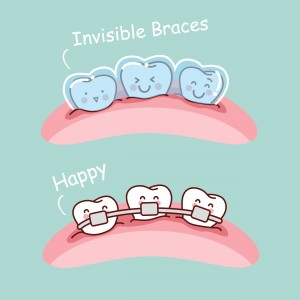Choosing between Invisalign vs braces can be a difficult decision. It’s helpful to know what each option entails, and compare the advantages and disadvantages of each. Keep in mind that Invisalign is not an effective option for everyone, but braces can be used for most corrections. If both options are available to you, consider these factors to make the right choice based on your needs, expectations, and lifestyle. We’ve updated this post in 2022 to give you more information and help you decide between Invisalign vs braces.
Invisalign Vs Braces: Understanding Each
One of the best ways to decide between invisalign vs braces is to understand what each option is, and what each one requires to straighten your teeth. Let’s take a closer look.
What is Invisalign?
Invisalign is a type of clear aligner that makes relatively small adjustments to teeth. These types of orthodontic devices use a series of clear, plastic trays which are fitted to your teeth and make small adjustments. The patient must wear a series of clear aligners for about a year to a year and a half to make corrections. Throughout this process, the patient must revisit their orthodontist and get new aligners about every one or two weeks. Or, some services allow the patient to obtain new aligners themselves as needed through the mail.
Invisalign is preferable for some patients because the clear plastic trays aren’t easy to see. Many patients also feel more comfortable with Invisalign, since they move teeth more gradually. However, since Invisalign moves teeth more gradually, it may not be effective to make larger adjustments to teeth. Though Invisalign often makes smaller adjustments to teeth, it is more expensive in many cases, since it requires more resources to make each tray.
What are Braces?
Braces are metal wires that are attached to your teeth to slowly make adjustments over time. A strong glue holds each of the brackets to the teeth, while a metal wire holds the brackets together. Similar to Invisalign, a series of adjustments to the braces helps to shift teeth into position. Braces might be used to correct the spacing or angle of teeth, as well as some underbite or overbite issues.
There are several different types of braces. Different types of braces can be used to correct different dental issues. Damon braces are one type. These use sliding brackets instead of metal brackets and can shorten the length of treatment time. Ceramic braces use ceramic material instead of metal. These can be more subtle than metal braces, and might be a happy compromise for those who like the subtle appearance of Invisalign, but need a more serious alignment tool. Lingual braces are another types of braces, except they are attached to the inside of teeth, so they aren’t as visible. This may be another preferred type of braces for those who like the subtle appearance of Invisalign.
Invisalign Vs Braces: The Process
Now that you know the general similarities and differences between invisalign vs braces, it’s helpful to know the process behind each. Both Invisalign and braces work in similar ways; they both stretch the ligaments attached to the teeth and apply steady pressure to move teeth over an extended period of time. In order to keep teeth moving in the right direction, Invisalign and braces need regular readjustments. This process differs somewhat.
The Braces Process
The process behind braces requires regular assessments and readjustments with your dentist or orthodontist. During this process, your dental expert will assess your teeth to make sure they are healthy, and adjust the wires and brackets to keep teeth moving. Over time, this steady pressure will shift teeth. You’ll need to visit your dentist or orthodontist about every three or four weeks.
While you’re wearing braces, there will be some foods you can’t eat, such as sticky candy and popcorn. These foods can easily become trapped in your braces and cause problems. You’ll also need to brush and floss your teeth more carefully to make sure that food particles don’t become lodged in your braces or your teeth. However, you’ll be able to take part in every other activity just as you normally would. If you participate in contact sports, your braces won’t hinder you, but you should wear a mouthguard. You may get a toothache or you may feel soreness in your jaw after an adjustment. If this occurs, over-the-counter painkillers or ice can help, among other remedies.
The Invisalign Process
The process for adjusting your teeth through Invisalign is similar to braces, but there are a few differences. While you will wear braces all the time and they aren’t removable until the process is complete, you can take your Invisalign trays in and out. However, for the Invisalign process to work, you’ll need to wear them about 22 hours a day. If you’re tempted to take your Invisalign aligners in and out often, this might not be the best alignment option for you.
For Invisalign to continuously adjust your teeth, you’ll need a new tray about every week. Each tray is made to apply slight pressure to your teeth, which moves them slowly into the right position. Your dentist or orthodontist will make molds of your teeth and order new trays as needed. Or, some services allow you to make molds of your teeth at home and order new trays yourself.
Invisalign Vs Braces: Pros and ConsIn
Keep in mind that Invisalign is not an effective option for everyone, but braces can be used for most corrections. If both options are available to you, consider these factors to make the right choice based on your needs, expectations, and lifestyle.
Appearance

Invisalign 
- Clear and difficult to notice
- Removable
Traditional braces
- Made of metal
- Brackets may use colors as preferred
Alignment Complexity
The patient has little control over this issue. Invisalign will make subtle or moderate corrections to teeth, but it isn’t recommended for complex orthodontic issues. If teeth require only slight straightening or subtle movements, Invisalign might be the ideal option. However, if you have significant gaps, overcrowding, or turned teeth, braces will be faster and more effective. Invisalign trays aren’t able to grip teeth that are turned, especially bicuspids, so these will be difficult to realign using this method. If teeth are significantly different depths, or there are large gaps between teeth, this can also make it difficult for Invisalign to properly grip the teeth and align them.
Invisalign
- Suitable for minor to moderate alignment needs
- Not always effective for teeth that are turned, overcrowded or significantly separated
Traditional braces 
- Can effectively correct all types of orthodontic issues
Duration
Since they are made for less extreme corrections than braces, patients generally do not wear Invisalign as long as braces, however braces move teeth faster. Since Invisalign is generally used for more minor orthodontic corrections than traditional braces, this can be a difficult comparison. Patients usually wear Invisalign between 6 and 18 months, while braces stay on anywhere between 18 months and three years, depending on the issue.
Invisalign
- Usually worn 6 to 18 months
- Generally for correcting more minor issues
Traditional braces
- Worn between 18 months to three years
- May correct minor or dramatic misalignments
Discomfort
Invisalign uses a series of trays molded into just the right shape, which gently move teeth in the right direction over time. Braces use metal wire and secure brackets to put pressure on teeth and move them faster. Since they are made of metal and apply more pressure, braces cause more friction and discomfort than Invisalign. Most patients agree the discomfort of Invisalign is small.
While Invisalign is generally more comfortable than traditional braces, Invisalign can present other challenges for some patients. Since Invisalign trays are removable, some patients have trouble continuously wearing them when they experience discomfort. For this reason, braces are often more effective for younger children who may be tempted to remove Invisalign trays.
Invisalign 
- More comfortable
- Removable
- Repeated removal can make the correction ineffective
Traditional braces
- Can cause discomfort
- Not removable
- Patients are not tempted to remove them
Cleaning

Since braces can’t be removed like Invisalign trays, they can be brushed like you would normally brush your teeth. However, patients must be more diligent when brushing and flossing, as particles can easily get caught in the wires and brackets.
Invisalign
- Requires regular brushing in the morning and night
- Requires brushing after eating and before replacing trays
Traditional braces
- Requires more care when brushing
- Food can easily get caught in wires and brackets
Orthodontic Visits
When it comes to orthodontic visits, there is no clear winner between Invisalign vs braces. Patients should make appointments every 4 to 6 weeks, regardless of the type of corrector they use. However, Invisalign trays will be changed every two weeks, while braces will only be tightened during orthodontic appointments.
Invisalign
- Visit orthodontist every 4 to 6 weeks
- Replace trays every two weeks
Traditional braces
- Visit orthodontist every 4 to 6 weeks
- Tightened during appointments
Expense
Expense is often a deciding factor between Invisalign vs braces. Invisalign is more expensive than braces, usually by 20 to 50 percent. These costs can vary depending on location, the availability of payment plans, and the type of corrections you require. Getting an accurate estimate before choosing a corrector will help you compare the costs of each.
Invisalign
- Between $3,500 to $8,000
- Average cost is approximately $5,000
Traditional braces 
- Between $1,800 to $6,000
- Average cost is approximately $2,500
Foods
When wearing braces, patients must stay away from foods like gum, popcorn and apples, which can get stuck in the wires or brackets. Patients must also brush and floss carefully to avoid tooth decay. Invisalign trays are removable, so patients can remove them while eating and enjoy any foods they want. However, it will be important to brush after eating and replace the trays, while also brushing before bed and when you wake up.
Invisalign 
- No food restrictions
- Must brush after eating
Traditional braces
- No sticky, hard or chewy foods
- Brush and floss normally
Other Activities
Other activities, like sports, present additional considerations when it comes to Invisalign vs braces. Though neither braces nor Invisalign will stop you from playing sports, you will need to take special precautions. When wearing braces and playing sports, you’ll need a special mouthguard that will fit over your braces. Without the mouth guard, a hit to the face while wearing braces, the metal brackets and wire can cause much more damage. Your orthodontist can provide a special mouthguard that will fit over your braces.
The clear plastic in Invisalign doesn’t pose a threat to your teeth and gums, however the trays themselves can become damaged by a hard hit. You should probably remove the trays and use a mouth guard for especially intense sports, like football or boxing, but you can probably keep them in for a sport with less contact, like tennis or basketball. If you’re not sure, ask your orthodontist. Remember, you’ll still need to wear the Invisalign trays for at least 20 hours a day.
Invisalign 
- Not necessary to remove during most sports
- Remove and use a mouth guard for contact sports
Traditional braces
- Wear a mouth guard over your braces during all sports
When deciding between Invisalign vs braces, consider all the factors and ask yourself which option would work best for you. If you’re not sure, ask your orthodontic specialist which they would recommend. Both Invisalign and braces are long-term investments, so it’s a good idea to compare prices, compare specialists, and budget accordingly. To learn more or get an estimate for Invisalign or braces, make an appointment at BDG today.

